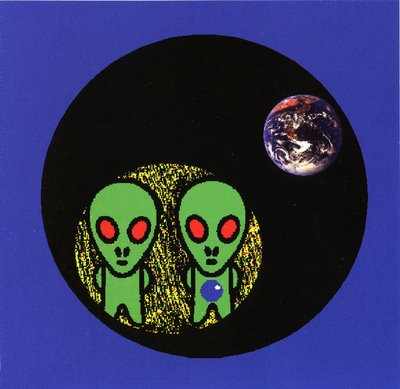 It's now time for another edition in that least popular of my posts, the "What I've Been Listening to Lately" series. No one cares what a blogger is listening to any more than I care what's playing in a car in the opposite lane of traffic, but it amuses me to review my own CD collection and what the hell - it's my blog. So there.
It's now time for another edition in that least popular of my posts, the "What I've Been Listening to Lately" series. No one cares what a blogger is listening to any more than I care what's playing in a car in the opposite lane of traffic, but it amuses me to review my own CD collection and what the hell - it's my blog. So there.Anyway, John Coltrane and Claude Challe have recently been bumped out of my CD changer by German electronic musician Pete Namlook. Namlook is a dizzyingly prolific composer who's steadily built an entire industry around his Frankfurt-based Fax label. At one point, Fax's release schedule was up to a CD per week for more than a year, and currently produces 24 per year, many of them Namlook's own, as well as numerous collaborations. But for all I know, Namlook may be the only artist on his label, and his "collaborators" merely alter egos - after all, who are Mixmaster Morris, Dr. Atmo, Tetsu Inoue, Geir Jenssen, Atom Heart, Jonah Sharp, and David Moufang? Granted, Fax has released a Pink Floyd-inspired "Dark Side of the Moog" series of collaborations with Namlook and Klaus Schulze (formerly of Tangerine Dream) and Bill Laswell, but the only other "collaborator" that I've ever heard of is Richie Hawtin, and I only heard of him from other Fax recordings.
Although Namlook got his start composing techno (such as the 4 Voice CD), he has since become synonymous with "new ambient" music. A "typical" new ambient recording combines droning electronics with, depending on the project or collaborator, ethnic instrumentation (tabla, tambouri, oud), environmental samples (rain, voices, arriving and departing trains, wildlife), sweeping electronic treatments, and minimal acoustic and electronic rhythms (jungle, electro, techno and trance).
Ambient music was more or less invented by Brian Eno, who originally conceived of a musical style with no hooks or beat that could serve as "background" or "aural wallpaper" for daily life. However, unlike Muzak, Eno's ambient music was composed to be interesting to listen to if you bothered to make the effort, but was also entirely forgetable; in fact, it invited the listener to ignore it. Namlook, however, seems to use ambiance to draw the listener in - he has recorded some of the most addictive, compulsively listenable instrumental electronica ever recorded.
Namlook's modes of recording are as varied as his recordings are prolific. In addition to his new ambient style, he has recorded CDs of ambient dub (Psychonavigation), ambient trance (The Fires of Ork), environmental ambiance, ethno-ambiance, space ambiance, industrial ambiance, dance, drum and bass, experimental, IDM, and even a type of "jazz."
For an introduction to this music, check out 2002's Ambient Cookbook, a four-CD retrospective of Fax recordings, or A View to a Chill, a two-CD overview. Or, to go to the source recordings themselves, start with Air 1 (1994), a set of French female vocal samples over lazy, brooding space music. The follow-up Air II adds ethno-ambiance through a didgeridoo and a rain stick. By the time we get to Air IV, the French samples almost overwhelm the instruments, but it's typical of Namlook to record albums in series, each of which builds on its predecessor. In addition to Air I-IV, we've got Dark Side of the Moog I-IX, Jet Chamber I-V, New Organic Life I-III, Outland I-III, Psychonavigation I-V, and so on.
I've got a pretty big backlog of Namlook recording to work through, so I'll probably be posting more reviews of individual albums in the weeks to come.

No comments:
Post a Comment